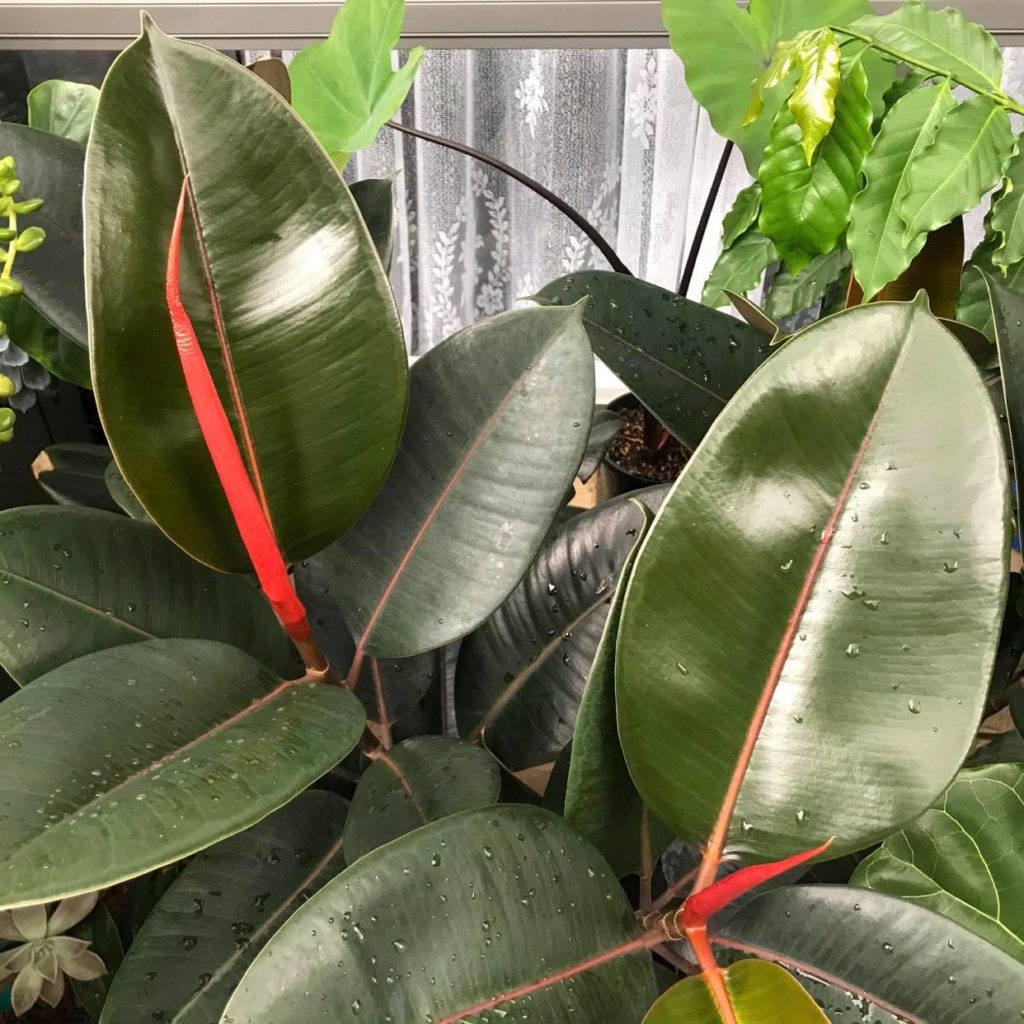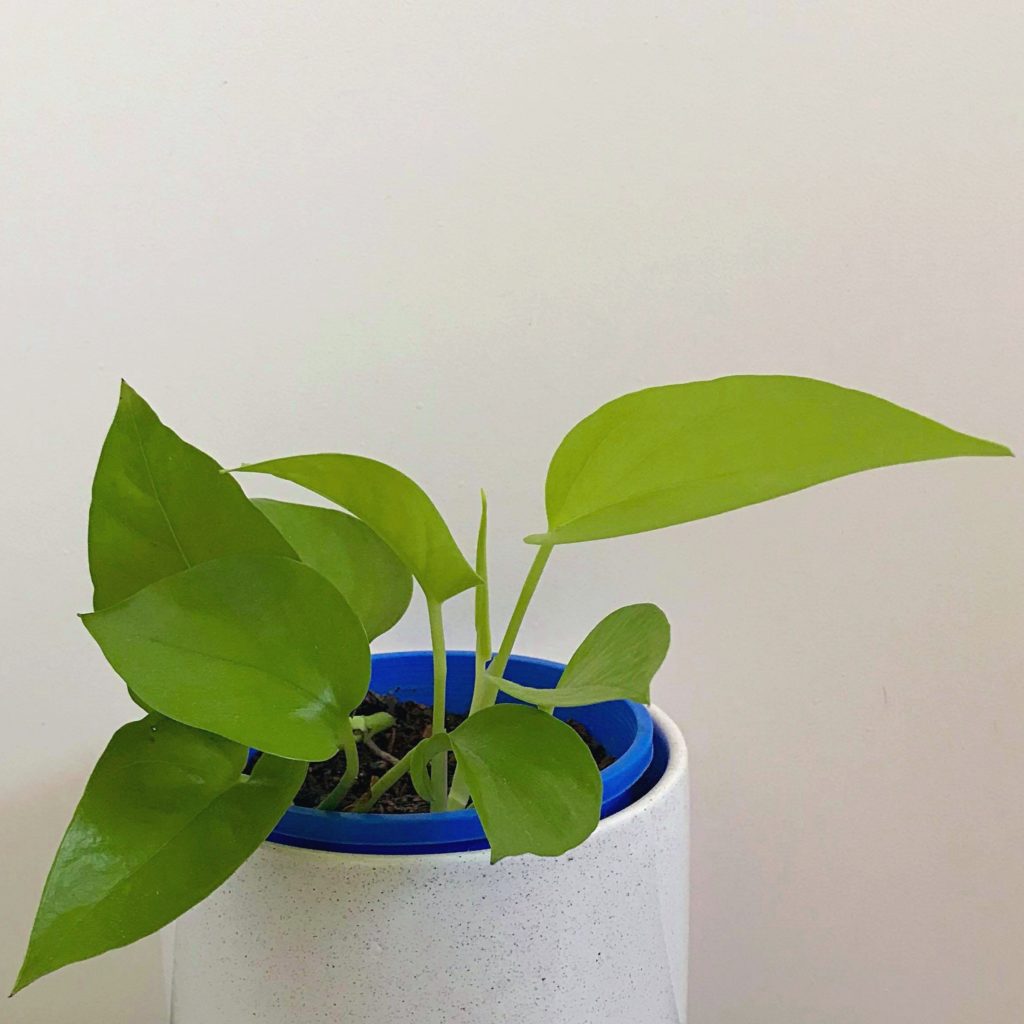Ficus Elastica aka Rubber Plant/Rubber Tree
Rubber Plants (Ficus Elastica) are part of the Moraceae family and are native to eastern parts of South and Southeast Asia. Rubber Plants come in a variety of different colours and patterns ranging from greens to variegated with pinks. They have large, glossy leaves and can grow up to 25+ feet when grown outdoors.
Ficus Elastica are a great beginner plant as they’re easy to care for and will thrive in bright indirect light while maintaining a moderate humidity. However, be sure to keep this plant away from pets and children as it contains a white sap that is mildly toxic.

Rubber Plant Quick Overview
| Full Size | Between 6 and 10 feet tall |
| Light | Bright filtered light |
| Temperature | Between 65 to 80˚F (18 to 27˚C) |
| Humidity | Medium (40%-50%) |
| Cost | $ |
| Care Level | Beginner |
| Toxicity | Toxic |
Size
The mature size of a Rubber Plant can be upwards of 50-100 feet in height. When grown indoors, you can expect it to reach about 6-10 feet in height. The leaves of a Rubber Plant can reach up to 8-12 inches in length. In the correct conditions, Rubber Plants can grow quite fast. Regular pruning will help to keep your plant at a height that best suits you. You can then keep those cutting to propagate into a new plant.
Light Requirements
Rubber Plants will grow best when in bright indirect lighting. This plant requires about 6-8 hours of bright light a day. However, these plants can sometimes tolerate lower light conditions. A sign that your Rubber Plant isn’t receiving enough light is if the plant becomes leggy, loses its luster and/or lower leaves are falling off. This can be resolved by moving it to a spot where it will receive brighter light.
Rubber Plants can be conditioned to live in full sun. The process of light conditioning is called hardening. This can be done successfully by gradually introducing your plant to more and more light, whilst increasing duration of sun exposure. Be sure to slowly acclimate your plant to avoid sun damage. A sign that your Rubber Plant has received too much direct light is scorched leaves.
Adding a blind or curtain to your window will help to defuse the harsh sunlight to avoid burning the plants foliage. Alternatively, if you can’t seem to find that perfect spot in your home, you can always use grow lights. Just like direct sunlight, if your plant is sitting too close to the grow lights, they will burn the foliage. Keeping a safe distance of at least 60cm between your plant and the light will avoid any trouble.
Temperature
The ideal temperature for growing Rubber Plants is between 65ºF-80ºF (18ºC-27ºC). The ideal temperature during the night is between 60ºF-65ºF (15ºC-18ºC). These plants prefer warmer climates and if the temperature drops below 55ºF (12ºC), you should move your Rubber Plant to a warmer spot. Being kept outside of these temperature brackets for prolonged periods of time can lead to poor plant health.
Humidity
Rubber Plants will be happy when kept in an average (40%-50%) humidity environment. These plants don’t like dry air, so providing a higher humidity will help to promote new and healthy growth. There are a few thing you can do that can help bump up the humidity in your home. The things you can try are:
- Misting your plants
- Pebble trays
- Grouping plants together
- Humidifier
You can read more about increasing humidity in your home here.
Watering Requirements
Rubber Plants like to be moderately watered. You can expect your plant to need water at least once a week. In the dormant season, watering won’t be required as often. You should check the top few inches of soil with your finger to feel if the soil is still moist. If the soil is dry, you should give your plant a drink. A sign that your Rubber Plant needs water is drooping leaves.
When watering your Rubber Plants, you should be cautious of over-watering. Excess water to the soil can cause it to become waterlogged. This can cause the roots to start rotting which stops them from being able to take in any water or nutrients to the plant. This can cause fungus issues, pest problems and root-rot. A sign that you may have over-watered your Rubber Plant are yellowing leaves.
Fertilizing requirements
You should fertilise your Rubber Plants every 4-6 weeks during Spring and Summer. You can cut back on fertiliser during the cooler months when the plant isn’t actively growing. Applying fertilizer while your plants aren’t using all the nutrients in the soil can cause salt build up and root burn. Fertilizing your plants will give them the essential nutrients they need for promoting and maintaining new and healthy growth.
The best fertiliser to use for Rubber Plants would be a balanced all purpose fertiliser diluted to half strength. Depending on what you prefer, you can either use a liquid fertiliser or a slow release fertiliser. If you use a slow release fertiliser, you won’t need to fertilise as often. This will assist in keeping your plant happy as well as promote new and healthy growth. Signs that your Rubber Plant might need fertilising is stunted growth, foliage losing colour and leggy growth.
Another thing you need to be cautious of when fertilising your houseplants is over-fertilising. A sign that you’ve over-fertilised your Rubber Plant is yellow and drooping leaves, stunted growth and fertiliser build up on the soil. Over-fertilising your plants can burn the roots and foliage. If you think you’ve over-fertilised your plant, you can either change the soil or rinse the fertiliser out. The water colour will change once the fertiliser has been rinsed out.
For more information on fertilising houseplants click here.
Soil Requirements
Rubber Plants like to be kept in a well draining soil. To achieve a well draining soil, you can use a mix of potting soil, orchid bark, perlite and peat moss. This helps to create better aeration and drainage. Airflow is important in potting soil as it allows the plants roots to breath. Not having enough oxygen to the roots can cause them to eventually start rotting.
Adding other organic materials such as coco coir, mulch chunks and coconut husk to the soil can also help to restrain moisture. It’s important to use ingredients that will help keep moisture in the soil but not keep it soggy. These plants don’t like to sit in water so the soil you use is important. You can also add garden compost to the soil to help create more richness.
Diseases & Pests
The common pests you may encounter on your Rubber Plants are Aphids, Scale, Mealybugs, Spider Mites, Fungus Gnats and Thrips. The common diseases you may encounter are Powdery Mildew, Southern Blight, Leaf Spot, Rust and Root-rot. For more information on identifying and treating common houseplant pests click here.
The best thing you can do when it comes to pests on houseplants is to try and avoid any pest infestations from starting. There are a few things you can do that will assist in preventing any pest infestations and these things are:
- Checking new plants for pests or isolating new plants for up to a week.
- Check your plants every few days for pests.
- Trim off any dead or dying leaves.
- Wipe down leaves if you notice them getting dusty.
- Keeping your plants healthy. A healthy plant will be able to handle an infestation better than those that aren’t as happy.
- Isolate any plants that have pests.
Following this will assist in keeping pests away as well as catch them early on before any severe infestations are able to start. Keeping plants healthy and in the correct living environments can help to deter any pests from invading your plants.
Toxicity
Rubber Plants are considered to be mildly toxic to both humans and pets. Ficus Elastica have a white sap that causes skin irritation and possible vomiting if ingested as well as mouth and stomach irritation.



